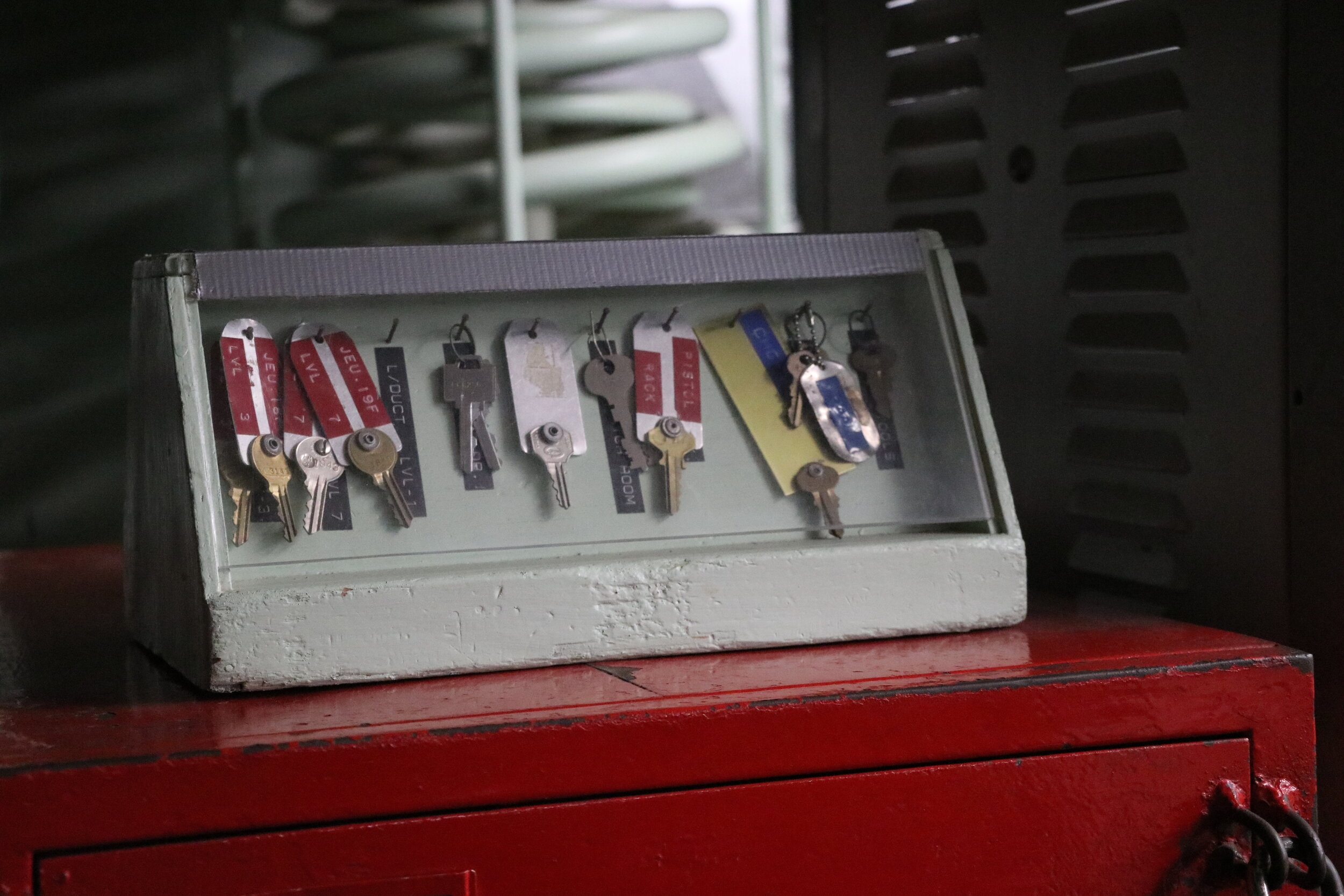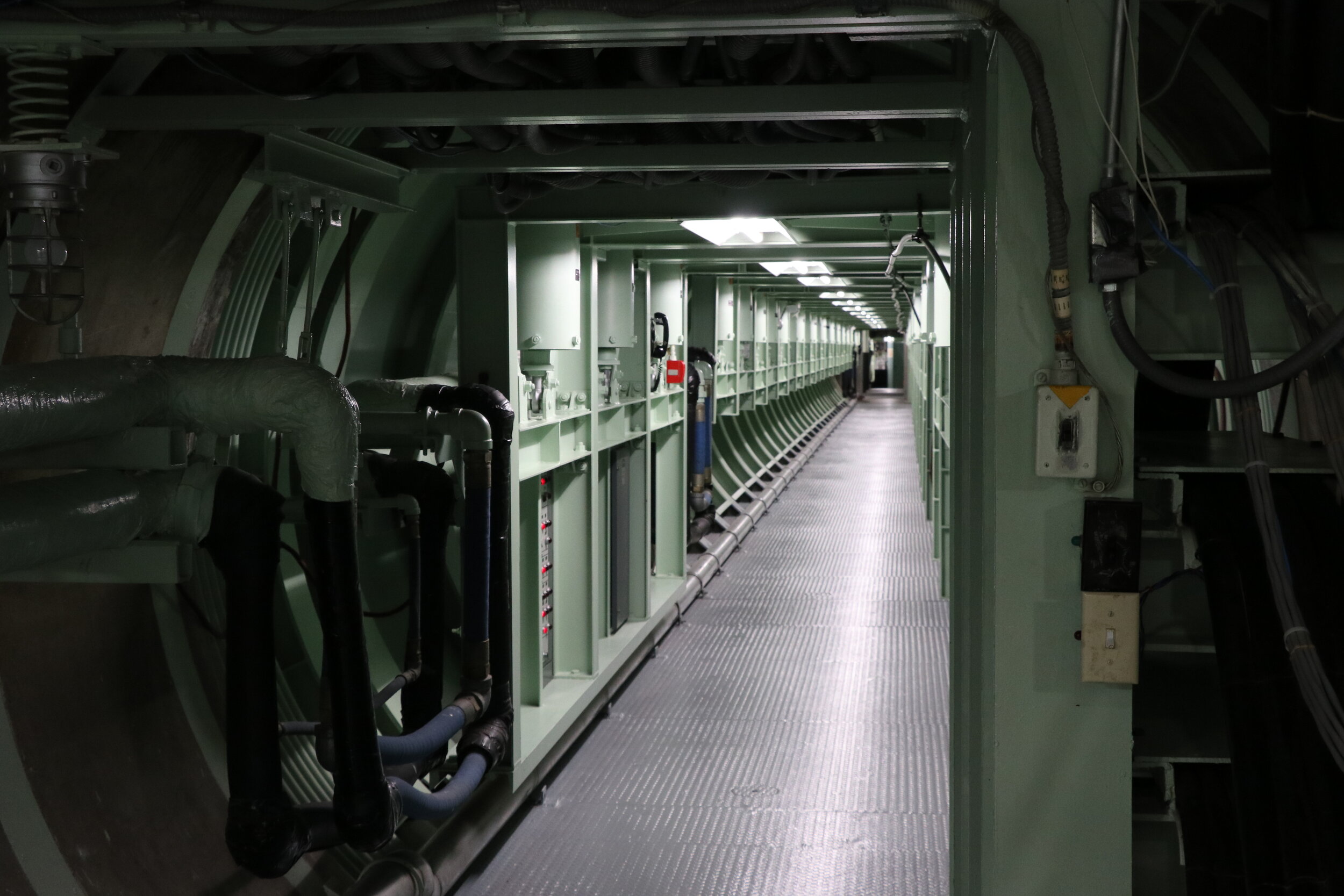Pima County
Titan II Missile [571-7]
The Titan II missile sits in the silo near Green Valley. The nuclear warhead has since been removed.
To the un-assuming passerby, the few cement pads and fenced area of a Titan II missile site wouldn’t seem very imposing. From the surface, there is no evidence of the massive nuclear weapon that is hiding underground, and all of the crew quarters and maintenance facilities required to launch it. This was the beauty of a Titan II silo which was used during the height of the Cold War when tensions were high with the Soviet Union. This site, 25 miles south of Tucson is the only surviving and best preserved example of a fully functioning launch facility.
The Titan II was an intercontinental ballistic missile (ICBM) developed in the 1960s. The motto was “Peace through deterrence”. The idea was -- if the Soviet Union ever launched a nuclear strike on the United States, they knew that they would be met with equal or more devastating destruction. “M.A.D” or ‘mutually assured destruction’ meant that this war wouldn’t be fought on the battlefields or oceans, but rather, thousands of miles apart, with weapons pointed at each other ‘just in case’.
This silo in Sahuarita, officially designated as 571-7, was one of 18 missile silos built surrounding Davis Mothan AFB and the Tucson Area. In total, there were 54 silos constructed in three states, with 18 additional sites surrounding McConnell AFB in Kansas and 18 sites surrounding Little Rock AFB in Arkansas. The missile program was developed throughout the early 1960s and the silos were soon constructed in their respective locations within a couple years. 571-7 was activated in 1963.
The main launch console and missile status panels in the background.
The construction of the underground facility was impressive. The launch silo was 9-stories deep and had to be able to house the 103’ tall missile weighing in over 300,000 pounds when fully loaded. The silo was connected to a three-story control center by at 250’ underground cableway. The control center was located on level 2 with crew sleeping quarters & kitchen located a level up, and additional equipment & emergency supplies located one level below. The underground facility was designed to withstand a nuclear near-miss, which meant the site could still be fully operational after being hit by a nuclear strike in the area. The facility features 3-ton blast doors, 8 foot thick concrete walls, and the entire silo is actually isolated from the nearby bedrock using large springs to absorb seismic waves from a nearby nuclear strike.
This safe would have been opened by two separate people before launch.
Those working at the silo faced the utmost security measures. Crews of four people worked four day rotations and were ‘on alert’ for the first and last 24 hours of their shift. Crew tasks were often repetitive and had long periods of boredom. When crews first arrived on duty, they conducted a thorough search of the facility. Paperwork and logs were kept to document all findings. They inspected equipment and performed routine maintenance checks to ensure that the missile was always ready to be launched. The crews working at the silo fortunately never had to launch the missile, but if they had to, the process was complicated.
Upon receiving orders to launch, the crew would first have to go through the process of decoding and confirming the instructions were real. A dual locked safe would need to be unlocked by two people -- the crew commander and another senior crew member. The dual locks prevented one person from accessing the sensitive information inside. Once unlocked, the launch keys, target information, and launch codes would be retrieved. The butterfly valve, preventing the missile from launching prematurely would then be unlocked. Each silo had three ‘pre-programmed’ targets that was unknown to the crew. Each target could have been either an air-burst (where the missile explodes above the target) or a direct hit. The targets have never been known, but it is safe to presume that they would have been high-value targets located within the Soviet Union.
The launch console lights up during a simulated launch.
With the launch keys, two crewmembers would have to simultaneously turn the keys in their respective stations. Both of the keys were spring-loaded and had to be held for five seconds. Each key was a far enough distance away that one person would not be able to turn both keys and initiate the launch sequence. Redundancy was the key. Upon activating the launch, the on-board missile batteries would be charged, the final guidance computers would be updated, and the missile would begin the launch sequence. Within 60 seconds, the missile would be leaving the silo and on the way to its target. From this point, there was no return.
If a Titan II hit Phoenix, everything in yellow would be destroyed.
Due to the nature of the fuel used on Titan II, once it was burning, there was no way the missile could be shut off or cancelled. Liquid fuel, combined with the oxidizer element created a chemical reaction that would create the propellant used to drive the missile. This method of fuel was much safer than prior missile programs, and allowed fuel to be stored separately on board the missile, saving valuable time in the launch process. Once the butterfly valve was opened, this sequence was initiated and there was no stopping it. The two stage 1 engines burned for 156 seconds. After this, the stage 2 engine ignited and burned for an additional 180 seconds. Stage 2 then separated. The nuclear warhead, now in a low earth orbit would continue falling towards the target, making minor corrections as needed to hit something as far as 5,500 miles away.
The W-53 nuclear warhead aboard the reentry portion of the missile was the largest single weapon carried aboard an American ICBM. The 9 megaton bomb had tremendous power. Compared to the atomic bombs dropped on Hiroshima & Nagasaki during WWII, it was 400 times more powerful. A successful missile hit would leave around 900 square miles of destruction surrounding the nuclear strike. To put that in perspective, if a Titan II missile struck the center of Phoenix, it would destroy everything between Surprise and Mesa.
Fortunately for the world, the Titan II’s mission of “peace through deterrence” was successful. No missile was ever launched during the Cold War. Perhaps the silo's most heightened state of alert was on November 22, 1963, when President John F. Kennedy was assassinated. With this news, the keys used to launch were ordered to be placed on the tables near the launch consoles and wait until further instruction. Since the Pentagon later figured out the Soviet Union did not commit the crime, the missiles were never launched. But tensions remained high throughout the 1960s.
Looking at the missile from inside the silo.
The silo wasn’t decommissioned until 1982, when President Ronald Reagan announced his policy for the decommissioning of the Titan II missile program. Of the 54 silos, 53 were destroyed. Only 571-7 was spared to serve as a testament to the events and measures taken during the Cold War. This silo in Sahuarita was adopted by the Arizona Aerospace Foundation and in 1994, was designated a National Historic Place. As part of the peace treaty, the silo doors were halfway opened and cemented in positions, to prove to foreign satellites that the site was not ‘launch capable’.
Today, the museum is a showcase of life during the Cold War. Because all the remaining missile silos were dismantled and decommissioned, you won’t be able to ever see anything in this condition anywhere else. The museum features a small museum and a 1-hour guided tour. The walking tour takes you down 35 feet into the control center, where you will be part of a simulated launch, and also to the silo where you will be able to see the missile in place, minus the fuel and nuclear warhead. The topside features numerous displays on the different engines as well as the fueling rigs that were used to load the missile. It is truly a unique place that is worth the stop. Visit https://titanmissilemuseum.org/ for more information or visit them in person at 1580 W. Duval Mine Rd. Sahuarita, Arizona 85629.
Additional photos:
Sources:
Lange, Katie. “Teaching Deterrence: This Nuclear Missile Bunker Takes Visitors.” U.S. DEPARTMENT OF DEFENSE, 30 Nov. 2018, www.defense.gov/explore/story/Article/1701023/teaching-deterrence-this-nuclear-missile-bunker-takes-visitors/.
“LGM-25C Titan II.” Wikipedia, Wikimedia Foundation, 24 Dec. 2019, en.wikipedia.org/wiki/LGM-25C_Titan_II.
“Titan History - Titan Missile Museum - Underground Nuclear Missile Silo.” Titan Missile Museum, titanmissilemuseum.org/titan-history/.
“Titan Missile Museum.” Wikipedia, Wikimedia Foundation, 20 Jan. 2010, en.wikipedia.org/wiki/Titan_Missile_Museum.











